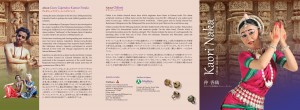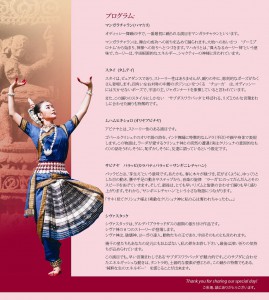 Indian Classical Dance ODISSI
Indian Classical Dance ODISSI
New Delhi, Delhi Kaori Naka Solo Programme
Date:27th Dec 2011
18:00 OPEN 18:30 START
Place:India International Centre
Everybody are welcome!


Dancer:Kaori Naka
Musicians:
Manjila :Guru Gajendra Panda
Ukuta: Guru Vinayak Panda
Vocal: Satyabrata Katha
Mardala: Prashanta Mangaraj
Violin: Balaram Chand
Sitar: Javed Alli
Flute: Binaya Kumar
Organized by India International Centre
Director and conducted by Guru Gajendra Kumar Panda
Supported by ICCR
Programme:
1) Mangalacharan Mahakali
The Mangalacharan is the traditional invocatory item of Odissi. This Mangalacharan is based on Kali
who is the Hindu goddess associated with cosmic power, shakti.
It begins with bhoomi pranam. This is followed by Isthadeva Vandana for an auspisious beginning.
It concludes with a shava pranam in which the dancer offers salutation to God, the Guru and to the audience.
Choreography: Guru Debaprasad das
Raga: Darabari
Tala: Ek tali & Jati tala
2) Sthai (Thum Thei)
Sthai is a pure dance woven around a garland of musical syllables which in themselves have no meaning. However,
the dance usually possesses a subtle thematic image related to sculptural poses
found in the Silpa Shastra (Treatise on temple architechure) and the typical rhythmic patterns of
Sabda Swara Pata (spoken verse) that is exclusive to the Debaprasad style.
Choreography: Guru Debaprasad das
Raga: Shankarabharan
Tala: Jati tala
3) Muhamuhi Kisoro (Oriya Abhinaya)
This is an expressional dance where a story conveyed to the audience through mudra or hand gestures
(the language of Indian classical dance), facial expression and body movement.
Taken from the work of the Orissan Medieval poet, Gopal Krishna, the adnce depicts Radha narrating
to her friends her unexpected encounter with Krishna on the banks of the Yamuna.
Choreography: Guru Debaprasad das
Raga: Bageshri
Tala: Ek tali
4) Sabhinaya Pallavi
Kalavati Pallavi
A pure dance item in which a raga is elaborated through eye movements, body postures & intricate footwork.
Pallavi literally means “blossoming”. This is applicable not only to the dance, but also to the music,
which accompanies it.
Pallavi starts with slow, graceful & lyrical movements of the eyes, neck, torso & feet
and slowly builds in a crescendo to climax in a fast tempo at the end.
Songinire Chahan
This Oriya Abhinaya means “Oh! my sakhi, look at Krishna”
Choreography: Guru Debaprasad das
Raga: Kalavati
Tala: Ek tali & Jati Tala
5) Sivastak
The Sivastak is the last composition of Guru Deba Prasad Das before his untimely death on 16th July 1986.
The dance is an invocation to Siva, where by the Bhakta / dancer eulogies his attributes and triumphs.
This dance brings out the inimitable stamp of the Parampara that make judicious use of a combination of verses,
Sabdha Swara Patha and pure dance in an organic and Inspired manner,
while bringing out the Tantric and tribal elements of Odissi.
Choreography: Guru Debaprasad das
Song: Shankara Chariya
Raga: Vhairabi
Tala: Ek tali


